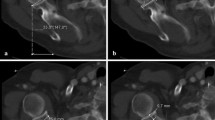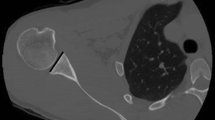Abstract
Purpose
Profound knowledge of variations in shoulder anatomy is gaining relevance in daily clinical work. In our study, we examine age-dependent variations of glenohumeral parameters in healthy individuals.
Methods
In this analysis, 774 severely injured patients who received a whole-body computed tomography (CT) scan were included. Patients with shoulder fractures were excluded. The resulting scans were split into two groups: patients younger than 25 (group 1) and older than 60 years (group 2). These groups were divided into four subgroups according to gender. Shoulder scans with advanced osteoarthritis were then removed. In order to maintain equal group size, redundant patients were randomly removed.
Results
A total of 210 measurements from 106 patients were included. The humeral head diameter (group 1: 41.6 ± 3.7 mm, group 2: 44.5 ± 3.7 mm, p < 0.001) and glenoid surface (group 1: 627.0 ± 110.8 mm2, group 2: 763.9 ± 148.5 mm2, p < 0.001) showed higher values in the group of older patients. Older patients also had a higher glenoid inclination (group 1: 50.9 ± 6.9°, group 2: 55.7 ± 8.8°, p < 0.001) as well as an increased glenoid to head ratio (group 1: 0.61 ± 0.04, group 2: 0.64 ± 0.05, p < 0.001).
Conclusions
Increased sizes of humeral head and glenoid surface are present in older patients without signs of osteoarthritis. Moreover, in patients with increased age more glenoid inclination as well as an increased glenoid to head ratio was revealed. These age-dependent anatomical parameters should be considered during planning of operative procedures of the shoulder joint.



Similar content being viewed by others
References
Kim SH, Wise BL, Zhang Y, Szabo RM (2011) Increasing incidence of shoulder arthroplasty in the United States. J Bone Joint Surg Am 93:2249–2254. doi:10.2106/jbjs.j.01994
Mansat P, Bonnevialle N (2015) Treatment of fracture sequelae of the proximal humerus: anatomical vs reverse shoulder prosthesis. Int Orthop 39:349–354. doi:10.1007/s00264-014-2651-0
Maurer A, Fucentese SF, Pfirrmann CW, Wirth SH, Djahangiri A, Jost B, Gerber C (2012) Assessment of glenoid inclination on routine clinical radiographs and computed tomography examinations of the shoulder. J Shoulder Elbow Surg 21:1096–1103. doi:10.1016/j.jse.2011.07.010
Bahrs C, Stojicevic T, Blumenstock G, Brorson S, Badke A, Stöckle U, Rolauffs B, Freude T (2014) Trends in epidemiology and patho-anatomical pattern of proximal humeral fractures. Int Orthop 38:1697–1704. doi:10.1007/s00264-014-2362-6
Gradl G, Knobe M, Pape HC, Neuhaus PV, Ring D, Guitton T (2015) Decision making in displaced fractures of the proximal humerus: fracture or surgeon based? Int Orthop 39:329–334. doi:10.1007/s00264-014-2630-5
Kircher J, Bittersohl B, Zilkens C, Hedtmann A, Krauspe R (2014) Biometrical analysis of the shoulder joint regarding glenoid implant dimensions for arthroplasty. Surg Radiol Anat 36:321–325. doi:10.1007/s00276-013-1197-y
Iannotti JP, Gabriel JP, Schneck SL, Evans BG, Misra S (1992) The normal glenohumeral relationships. An anatomical study of one hundred and forty shoulders. J Bone Joint Surg Am 74:491–500
Cay N, Tosun Ö, Doğan M, Karaoğlanoğlu M, Bozkurt M (2012) The effect of morphometric relationship between the glenoid fossa and the humeral head on rotator cuff pathology. Acta Orthop Traumatol Turc 46:325–331
Hoenecke HR Jr, Hermida JC, Flores-Hernandez C, D’Lima DD (2010) Accuracy of CT-based measurements of glenoid version for total shoulder arthroplasty. J Shoulder Elbow Surg 19:166–171. doi:10.1016/j.jse.2009.08.009
Walch G, Badet R, Boulahia A, Khoury A (1999) Morphologic study of the glenoid in primary glenohumeral osteoarthritis. J Arthroplasty 14:756–760
Matsumura N, Ogawa K, Ikegami H, Collin P, Walch G, Toyama Y (2014) Computed tomography measurement of glenoid vault version as an alternative measuring method for glenoid version. J Orthop Surg Res 9:17. doi:10.1186/1749-799x-9-17
Friedman RJ, Hawthorne KB, Genez BM (1992) The use of computerized tomography in the measurement of glenoid version. J Bone Joint Surg Am 74:1032–1037
Saccomanno MF, Cazzato G, Fodale M, Sircana G, Milano G (2015) Magnetic resonance imaging criteria for the assessment of the rotator cuff after repair: a systematic review. Knee Surg Sports Traumatol Arthrosc 23:423–442. doi:10.1007/s00167-014-3486-3
Nakamura Y, Yokoya S, Mochizuki Y, Harada Y, Kikugawa K, Ochi M (2015) Monitoring of progression of nonsurgically treated rotator cuff tears by magnetic resonance imaging. J Orthop Sci 20:314–320. doi:10.1007/s00776-014-0680-6
Kim YS, Yoo YS, Jang SW, Nair AV, Jin H, Song HS (2015) In vivo analysis of acromioclavicular joint motion after hook plate fixation using three-dimensional computed tomography. J Shoulder Elbow Surg 24:1106–1111. doi:10.1016/j.jse.2014.12.012
Suter T, Gerber Popp A, Zhang Y, Zhang C, Tashjian RZ, Henninger HB (2015) The influence of radiographic viewing perspective and demographics on the critical shoulder angle. J Shoulder Elbow Surg 24:e149–e158. doi:10.1016/j.jse.2014.10.021
Matsen FA 3rd, Warme WJ, Jackins SE (2014) Can the ream and run procedure improve glenohumeral relationships and function for shoulders with the arthritic triad? Clin Orthop Relat Res 473:2088–2096. doi:10.1007/s11999-014-4095-7
Hughes RE, Bryant CR, Hall JM, Wening J, Huston LJ, Kuhn JE, Carpenter JE, Blasier RB (2003) Glenoid inclination is associated with full-thickness rotator cuff tears. Clin Orthop Relat Res 407:86–91
Wong AS, Gallo L, Kuhn JE, Carpenter JE, Hughes RE (2003) The effect of glenoid inclination on superior humeral head migration. J Shoulder Elbow Surg 12:360–364. doi:10.1016/mse.2003.S1058274603000260
Moor BK, Bouaicha S, Rothenfluh DA, Sukthankar A, Gerber C (2013) Is there an association between the individual anatomy of the scapula and the development of rotator cuff tears or osteoarthritis of the glenohumeral joint?: A radiological study of the critical shoulder angle. Bone Joint J 95-B:935–941. doi:10.1302/0301-620x.95b7.31028
Frink M, Zeckey C, Mommsen P, Haasper C, Krettek C, Hildebrand F (2009) Polytrauma management - a single centre experience. Injury 40:S5–S11
Churchill RS, Brems JJ, Kotschi H (2001) Glenoid size, inclination, and version: an anatomic study. J Shoulder Elbow Surg 10:327–332. doi:10.1067/mse.2001.115269
Edelson JG (1995) Localized glenoid hypoplasia. An anatomic variation of possible clinical significance. Clin Orthop Relat Res 321:189–195
Roy JS, Braën C, Leblond J, Desmeules F, Dionne CE, MacDermid JC, Bureau NJ, Frémont P (2015) Diagnostic accuracy of ultrasonography, MRI and MR arthrography in the characterisation of rotator cuff disorders: a meta-analysis. Br J Sports Med. doi:10.1136/bjsports-2014-094148
Bailey LB, Beattie PF, Shanley E, Seitz AL, Thigpen CA (2015) Current rehabilitation applications for shoulder ultrasound imaging. J Orthop Sports Phys Ther 45:394–405. doi 10.2519/jospt.2015.4232
Waldt S, Brugel M (2015) Classification of normal labral variants and labral injuries (in German). Radiologe 55:211–220. doi:10.1007/s00117-014-2785-5
Author information
Authors and Affiliations
Corresponding author
Rights and permissions
About this article
Cite this article
Bockmann, B., Soschynski, S., Lechler, P. et al. Age-dependent variation of glenohumeral anatomy: a radiological study. International Orthopaedics (SICOT) 40, 87–93 (2016). https://doi.org/10.1007/s00264-015-2863-y
Received:
Revised:
Accepted:
Published:
Issue Date:
DOI: https://doi.org/10.1007/s00264-015-2863-y




